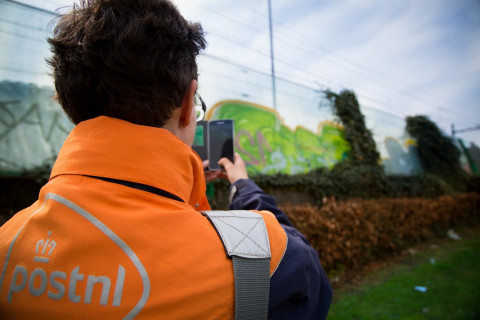Last September, the office of inspector general of US post published a report on postal services and smart cities. In a recent podcast, the authors of the report sketch three business models and five pilots for postal operators. The pilots are on using the postal trucks to measure the quality of the road (e.g. pothole detection), bridges (measuring vibrations on the bridge), air quality (sensors on a car) measuring the quality of underground water infrastructure (using long range Bluetooth transmitters) and measuring urban blight (using the local presence of the carrier).
Last September, the office of inspector general of US post published a report on postal services and smart cities. In a recent podcast, the authors of the report sketch three business models and five pilots for postal operators. The pilots are on using the postal trucks to measure the quality of the road (e.g. pothole detection), bridges (measuring vibrations on the bridge), air quality (sensors on a car) measuring the quality of underground water infrastructure (using long range Bluetooth transmitters) and measuring urban blight (using the local presence of the carrier).
There are many opportunities for using the postal networks as data collection networks. Interestingly, I see many postal operators working on the same kind of propositions. Read my earlier blogs for more examples from Spain and Belgium.
Not only the pilots several postal carriers conduct are comparable but also the discussion on business models. The first business model is to rent inches in postal trucks where a customer can place sensors in. The second one is to define what data may be interesting (and to whom) and to actually collect this data. The final business model is a “full service provider” model.
Of course, the full service provider business model is the most interesting, but also the one with the highest risk. If I, as a postal operator, invest my money in turning the network into an air quality measurement platform, who will be paying for this collected data? Questions like this one are the barriers for growth within the smart city domain and not only for postal operators, but also for producers of smart lights, smart parking sensors or smart bins.
Another issue arising from the podcast is how to deal with privacy concerns? Take the urban blight detection pilot for example. In this pilot, the mailman can inform the municipality with early signals of urban blight. The benefit of the postal service is that they are present in every street. The carrier can see when a house becomes vacant e.g. when mail is not picked up. Being able to capture the knowledge of the carrier would be a huge opportunity. You can collect the same kind of information in different cities and compare it. The question is to what extent and for what reason mailmen are willing to share information they have and society is willing the mailman to share this data. If postal operators are the data collectors of the smart city of the future, this question must be addressed in more detail.
Therefore, I’m happy to attend the Smart Cities and the Internet of Things (IoT) summit organized by PostEurop on November 24. As I wrote in an earlier blog, it’s my strong conviction that there is a brigt future for postal organizations. However, their license to operate should come from local neighborhoods, inhabitants and customers and not from government officials. I think there are three main conditions postal operators should have in mind and which I will bring to the summit:
Condition 1: Postal services are part of local communities
Postal operators have to think about their place within the local ecosystem of every neighborhood: we are a part of those communities and not ‘just’ a supplier or ‘just’ a data collector. Most of the postal workers (at least in the Netherlands) live as a neighbor in the area wherein they deliver mail and collect data. In terms of business models, postal organizations should therefore be transparent about their activities, actively involve (opt in) or inform (opt out) consumers in their propositions and ask local communities about their opinions on the services provided.
Condition 2: Trust in the Mailman, his Abilities and in the Corporate he works for
Asking postal workers to execute extra activities may sound attractive in PowerPoint presentations for decision makers, but in practice we have to realize that this ‘logic’ is not automatically seen by others. For example, mailmen checking elderly people need to have the personal trust of the elderly people (“I know you and you are a nice person”), in his abilities (“you are indeed able to have a good conversation with me”) and in the corporate asking him to do the extra job (“this is a brand I trust”). This three levels of trust will give the postal operator the license to operate within the smart city domain, as a trusted, able and nice partner within the local community.
Condition 3: Business Models with Societal Benefits
To be sure not to be detached from the local community and to keep the three levels of trust high, postal organizations should focus on business models with societal benefits. Such as data collection from public spaces in order to keep cities clean, pothole detection, checking health conditions of elderly people. Not surprisingly, it are these kind of models postal operators worldwide are developing. Doing good by doing business should be the motto of postal organizations in the smart city domain. If they do, they will also be a good alternative of criticized “big brother is watching you” projects which we also find in the Smart City domain.






Dear Gilles,
Thank you for your comment!
If you follow the link to the podcast, you will be hearing the definitions of the business models after 17 minutes and 10 seconds. To summarize:
Business model I: space rental approach. You rent out space on the vehicle. Postal not involved in execution of the pilot. It is just an extra service.
Business model II: slightly more active role of the data. Postal employer need to take action to collect the data. In this case the postal service is only involved in the data collection, not in ownership or analyzing the data
Business Model III: postal service as full service provider. The postal service does everything.
Great to be hearing drom you if you have any match! My contact details: Rogier@amsterdamsmartcity.com or add me on LinkedIn
Hello Rogier,
Thank you for this blog and sharing this look behind the scenes with us. Very interesting!
Nice to see that postal operators are already crossing over the different IoT verticals.
I'm not sure to understand the difference between model #2 and #3. Is in #2 also the postal operator making himself the choice of which data it thinks is interesting and of collecting it? If so what's the difference with #3 then?
I would consider your potential customer(s) business models. To which customer could postal operator unique capabilities be of interest? Do not forget to look at the risks. Which other options would be available to this other potential customer? This customer is probably busy with IoT itself and looking at the opportunities of connected objects for its goal.
I will keep you and this article in mind while talking to my customers and contact you if I see any match!
Thanks again.
Gilles